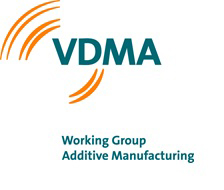
Between Fascination and Real Enthusiasm – the User Case Area at formnext 2019
Great rush to User Case Area – Demand for networking on the rise
Joint stand of the VDMA Additive Manufacturing Working Group also met with a good response
Frankfurt, December 5, 2019 – Hardly a quiet minute: For four days of the fair, the User Case Area of the Working Group Additive Manufacturing (AG AM) in the VDMA was a bustling place. Member companies had provided several dozen exhibits for the best practice exhibition at formnext (19 – 22 November 2019). The spectrum ranged from the finest gold jewelry from a micro powderbed fusion process at the Fraunhofer ILT Aachen presented under a magnifying glass to the hip-high sandprinted mold for an engine block. To demonstrate the variability of its binder jettings with sand and a phenolic binder, ExOne GmbH had brought with it size-scaled cast engine blocks in addition to the giant sand mold – including a miniature in matchbox format.
“The variety of our exhibits from various AM processes, materials and user industries had a great attraction for the trade fair visitors and caused real enthusiasm in many discussions,” reports Rainer Gebhardt, Project Manager of AG AM in the VDMA. Visitors were able to interactively explore the AM processes, materials and concrete added value of the best-practice solutions contributed by more than 30 member companies on tablets. The concept of the User Case Area also provided for visitors to pick up the fascinating exhibits and literally feel them.
And they did: whether multi-material cooling elements from Hermle’s own MPA process, a lightweight wheel suspension made of plastic and metal for the Formula Student from Kegelmann Technik, whether a corrosion-resistant impeller provided by the pump specialist KSB or individualised aluminium suction pads from Materialise or the plastic vacuum pads from Piab Vakuum presented in several variants. Visitors to the fair examined them, weighed them in their hands and asked numerous questions.
The crowd-pullers in the laser melting process were PROTIQ copper inductors and a cake-sized rolling bearing housing from Schaeffler AG. The laser build-up welding process used saves time, tool costs and around 55 percent of the copper-aluminum alloy used compared to machining from solid material. Above all, however, it is the reduced machining effort in the AM process that makes it possible to use this alloy with improved mechanical properties.
A two-channel heat exchanger from DMG MORI, which was realized in the hybrid process with an outer stainless steel tube and an inner copper-aluminum structure, also caused amazement. As in the case of a turbocharger impeller for marine diesel engines from GEFERTEC’s 3DMP® process chain, which was manufactured close to the final contour and weighs almost 20 kg, many of the exhibits were AM components in their raw, not yet finished state. Especially the aspect that additive manufacturing processes usually have to be followed by post-processing and finishing steps and how these are to be accomplished raised many technical questions from visitors to the User Case Area.
“Further exhibits came from our members Arburg, Additive Industries, Altair, AMF, Andritz, Bosch Rexroth, Coherent, DMRC, Hans Weber Additive, Krause Dimatec, Renishaw, Rosswag, SMS Group, Steinbach as well as MBFZ Toolcraft, Trumpf or Wibu Systems. On all four days of the fair, exciting technical discussions also take place on them,” reports Dr. Irene Hassinger, Project Manager of AG AM in the VDMA.
Compared to formnext 2018, the VDMA team has registered significantly increased visitor interest. “The visitors seemed to be more informed. Many were specifically interested in our working group and networking opportunities,” she explains. The AG Additive Manufacturing currently serves around 150 companies and research institutes as a networking platform under the umbrella of the VDMA. Plant manufacturers, suppliers of components and materials, service providers from the manufacturing, software and finishing sectors, researchers from leading universities and research institutes as well as numerous industrial users from numerous sectors are pursuing a common goal: the rapid industrialisation of additive manufacturing processes.
The significantly increased response to formnext 2019 – almost 35,000 visitors (2018: 27,000) streamed along the stands of 852 exhibitors (2018: 632) – and the internationality of the visitors from 99 countries was noticeable in the AG AM User Case Area from the first to the last day of the fair. The same applies to the joint stand where the member companies Festo, Harmonic Drive, InnoCast, ProtoTec, Kasto, Hans Weber Additive, A. Mannesmann and Schneeberger presented their solutions. “We have almost always received very positive feedback from them,” reports Gebhardt. The companies had especially praised the quality of the discussions.
At formnext 2019, AG AM dedicated its own space in the User Case Area to the future topic of qualification. On the one hand, the Braunschweig-based start-up fabmaker demonstrated its approaches to the training and further education of prospective AM specialists. On the other hand, AG AM prepared a position paper punctually for the leading global trade fair which shows current and future needs for action in and for the young industry. Hassinger emphasises a key point from this: “We must place the academic and industrial training for additive manufacturing on a uniform basis”. In order to achieve a broad industrial application of AM production technologies, the availability of qualified specialists is a mandatory prerequisite. “The same applies to the outstanding technological development towards the Smart Factory”, emphasizes Gebhardt, “in order to solve the abundant tasks of the future, we need an initiative to promote the training of skilled workers in the AM sector. The faster it comes, the better,” he warns.
About 150 companies and research institutes collaborate under the roof of the VDMA in the Additive Manufacturing Association. System manufacturers, suppliers of components and materials, industrial users from the metals and plastics sectors, services providers for software, manufacturing, and finishing as well as researchers all have a common goal: the industrialization of additive manufacturing technologies.